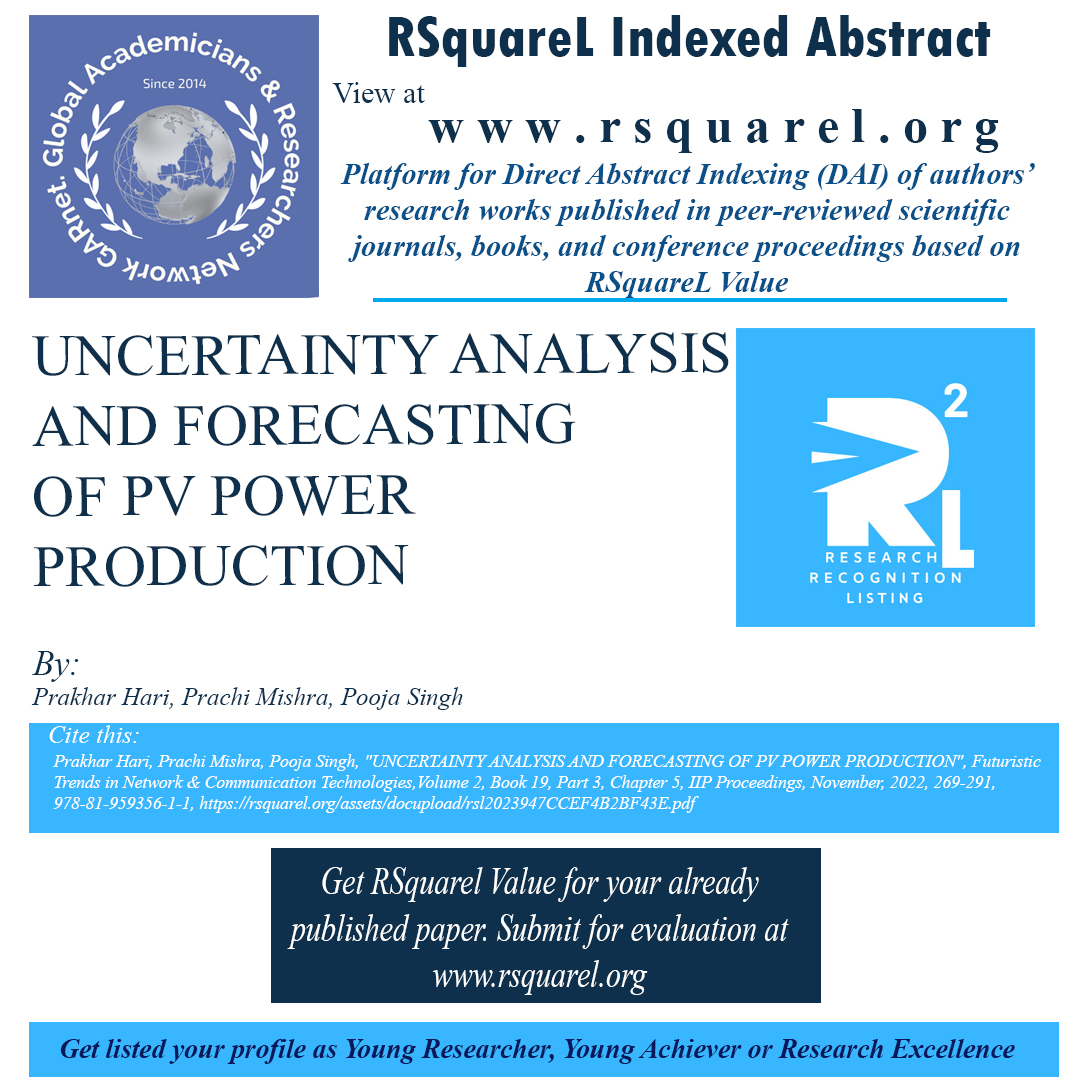editedbook
Publication: IIP Proceedings Year: 2022, Month: November Page No: 269-291, ISSN/ISBN: 978-81-959356-1-1, DOI/Link: https://rsquarel.org/assets/docupload/rsl2023947CCEF4B2BF43E.pdf
UNCERTAINTY ANALYSIS AND FORECASTING OF PV POWER PRODUCTION
Area/Stream: Network & Communication Technologies , Authors: Prakhar Hari, Prachi Mishra, Pooja Singh Keywords: Photovoltaic (PV), PV power generation, Power prediction and forecasting of PV power, ANN and WD in PV power Book Name /series: Futuristic Trends in Network & Communication Technologies,Volume 2, Book 19, Part 3, Chapter 5Publication: IIP Proceedings Year: 2022, Month: November Page No: 269-291, ISSN/ISBN: 978-81-959356-1-1, DOI/Link: https://rsquarel.org/assets/docupload/rsl2023947CCEF4B2BF43E.pdf
Abstract:
In today’s time, the ecological condition and the energy supply has become critical around the world. The important reason for the growth and application of renewable energy sources is the limitation of non-renewable sources. The most ideal nonrenewable energy source is solar energy. The important feature in solar energy consumption patterns is photovoltaic power generation, but the output of photovoltaic power plant is irregular and changes frequently. The current work introduces an empirical ground framework for the analysis of uncertainty and forecasting of photovoltaic (PV) power generation. The energy system has momentarily affected by the photovoltaic (PV) generation, when PV infiltration rises to a very huge level since this source has high inconsistency and uncertainty, to analyse our data smoother we developed a method to remove the periodic component. We can regulate the ambiguity of PV data by discarding the periodic effect of the sun in the sky. To determine predictable low-frequency components in the system operation we have used the least squares method. The least square method can be applied to valuation the probabilistic characteristics of PV generation at many sites on the earth concerning the different solar radiation due to changing solar position, PV generation has distinct probability distribution at different locations on the earth. The nature of the solar position is deterministic and periodic. By observing the data precisely to characterize the uncertainty we can abolish the effect of periodicity. In power generation the forecasting of the output of photovoltaic power is essential and the forecasting is necessary for timely electric power distribution and to boost the authenticity of electrical energy system operation, this problem can be solicited withthe help of artificial neural network (ANN) and the wavelet decomposition (WD). To address the voltage-current relationship a hybrid model is created which is based on an artificial neural network (ANN) and wavelet decomposition (WD), the climatic variables and solar irradiance are the input for this hybrid model. Wavelet decomposition is used to separate the required useful information from the disturbance in the PV power plant output. Based on decomposed output (in WD) models are created with the artificial neural network and then the output of the artificial neural network model is reconstructed in the forecasted photovoltaic plant power output. Here in this approach, we compare the traditional forecasting method which is based on an artificial neural network (ANN). Based on this we can analyse the discrepancy of renewable energy sources with different characteristics (i.e., non-stationary) and ambiguous components. In this approach, the nonlinear PV behaviour is captured by the AI technique and wavelet transform shows the impact on ill-behaved of photovoltaic time series data.
Cite this: Prakhar Hari, Prachi Mishra, Pooja Singh,"UNCERTAINTY ANALYSIS AND FORECASTING OF PV POWER PRODUCTION", Futuristic Trends in Network & Communication Technologies,Volume 2, Book 19, Part 3, Chapter 5, November, 2022, 269-291, 978-81-959356-1-1, https://rsquarel.org/assets/docupload/rsl2023947CCEF4B2BF43E.pdf
Views: 11980
Download File
News
